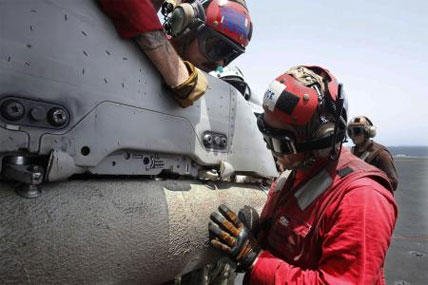USS ENTERPRISE, At sea – From dawn to setting sun and throughout the night, Marine Fighter Attack Squadron 251 is proudly supporting Operation Enduring Freedom while deployed aboard the aircraft carrier USS Enterprise.
This would not be possible without the squadron’s ordnance division providing aircraft defensive and offensive munitions allowing pilots to provide close air support.
Red flight deck jerseys and cranials designate the ordnance division Marines and sailors aboard the carrier as they work on the flight deck and in the hangar.
“As we progress through this deployment, our Marines are getting closer and are becoming more proficient while completing the task in hand,” said Gunnery Sgt. Jaime Salazar, VMFA-251 ordnance staff non-commissioned officer-in-charge.
Ordnance technicians are responsible for the mounting, arming and maintenance performance required for all ordnance from the F/A-18 Hornet’s cannon to missiles and bombs.
The carrier is currently conducting maritime security operations in the U.S. 5th Fleet area of responsibility while supporting OEF before becoming decommissioned after more than 50 years of service.
“This deployment gives everyone a great learning experience as we get the opportunity to work on a flight deck while at sea and I personally get to see how everything in the ordnance division operates at the squadron level,” said Lance Cpl. Tom Lor, a VMFA-251 intermediate level ordnance technician who is currently temporary additional duty from Marine Aviation Logistics Squadron 31 to work at the operational level.
Intermediate level Marines work primarily on the assembly of bombs, bomb racks and other accessories associated with ordnance. Most intermediate level Marines never work on the flightline unlike their counterparts at the operational level.
Ordnance Marines working on the flight deck ensure munitions are properly unloaded and loaded onto the aircraft. Checks for the proper arming and seating of all munitions are also conducted during safe- for-flight inspections.
“It’s nice to know we are able to contribute to the fight even though we are not actually holding a rifle and have our boots on the ground,” said Lor, a native of Mount Airy, N.C.
The Thunderbolts have participated in nearly 300 flight hours supporting OEF and are expected to further support the operation during the deployment.
“We are here to provide air support for our troops on the ground and potentially save lives of NATO forces,” concluded Salazar, a Beeville, Texas native.





























